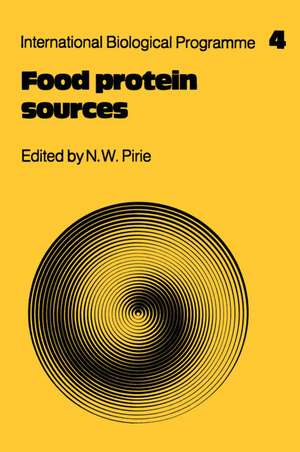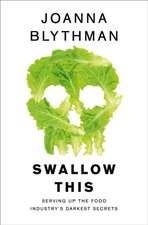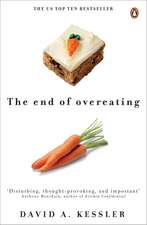Food Protein Sources: International Biological Programme Synthesis Series, cartea 4
Autor N. W. Pirieen Limba Engleză Paperback – 11 ian 2012
Din seria International Biological Programme Synthesis Series
-
 Preț: 318.64 lei
Preț: 318.64 lei - 11%
 Preț: 457.82 lei
Preț: 457.82 lei -
 Preț: 353.87 lei
Preț: 353.87 lei -
 Preț: 400.82 lei
Preț: 400.82 lei -
 Preț: 382.99 lei
Preț: 382.99 lei - 5%
 Preț: 336.68 lei
Preț: 336.68 lei -
 Preț: 426.62 lei
Preț: 426.62 lei - 11%
 Preț: 440.62 lei
Preț: 440.62 lei -
 Preț: 383.15 lei
Preț: 383.15 lei - 11%
 Preț: 559.94 lei
Preț: 559.94 lei -
 Preț: 431.88 lei
Preț: 431.88 lei -
 Preț: 403.66 lei
Preț: 403.66 lei -
 Preț: 356.15 lei
Preț: 356.15 lei -
 Preț: 451.34 lei
Preț: 451.34 lei - 11%
 Preț: 601.71 lei
Preț: 601.71 lei -
 Preț: 354.03 lei
Preț: 354.03 lei -
 Preț: 432.86 lei
Preț: 432.86 lei - 11%
 Preț: 482.41 lei
Preț: 482.41 lei -
 Preț: 404.90 lei
Preț: 404.90 lei -
 Preț: 405.66 lei
Preț: 405.66 lei -
 Preț: 452.32 lei
Preț: 452.32 lei -
 Preț: 313.72 lei
Preț: 313.72 lei
Preț: 284.78 lei
Nou
Puncte Express: 427
Preț estimativ în valută:
54.50€ • 56.75$ • 46.06£
54.50€ • 56.75$ • 46.06£
Carte tipărită la comandă
Livrare economică 07-21 martie
Preluare comenzi: 021 569.72.76
Specificații
ISBN-13: 9781107403826
ISBN-10: 1107403820
Pagini: 284
Dimensiuni: 152 x 229 x 15 mm
Greutate: 0.38 kg
Editura: Cambridge University Press
Colecția Cambridge University Press
Seria International Biological Programme Synthesis Series
Locul publicării:New York, United States
ISBN-10: 1107403820
Pagini: 284
Dimensiuni: 152 x 229 x 15 mm
Greutate: 0.38 kg
Editura: Cambridge University Press
Colecția Cambridge University Press
Seria International Biological Programme Synthesis Series
Locul publicării:New York, United States
Cuprins
List of contributors; Preface; Part I. Sources Edible after Minimal Processing: 1. Protein-rich cereal seeds A. K. Kaul; 2. Varietal improvement of seed legumes in India L. M. Jeswani; 3. Minor food seeds D. A. V. Dendy, Bernice Emmett and O. L. Oke; 4. Vegetables F. W. Shepherd; 5. The Spirulina algae N. W. Pirie; 6. Green micro-algae H. Tamiya; Part II. Concentrates Made by Mechanical Extraction: 7. Protein products from coconuts D. A. Dendy; 8. Soybeans: processing and products S. J. Circle and A. K. Smith; 9. Rapeseed and other crucifers R. Ohlson and R. Sepp; 10. Sunflower, safflower, sesame and castor protein Antoinette A. Betschart, C. K. Lyon and G. O. Kohler; 11. Groundnut O. L. Oke, R. H. Smith and A. A. Woodham; 12. Broad bean A. Hagberg and J. Sjödin; 13. Concentrates by wet and dry processing of cereals R. M. Saunders and G. O. Kohler; 14. Leaf protein N. W. Pirie; 15. Industrial production of leaf protein in the USA G. O. Kohler and E. M. Bickoff; Part III. Concentrates Made by Biological Conversion: 16. Protein from non-domesticated herbivores K. L. Blaxter; 17. The use of non-protein nitrogen by ruminants T. R. Preston; 18. Non-protein nitrogen in pig nutrition R. Braude; 19. The domestic non-ruminant animal as consumer and provider of protein A. A. Woodham; 20. The conversion of animal products such as wool and feathers into food F. B. Shorland; 21. Increasing the direct consumption of fish G. H. O. Burgess; 22. Funghi W. E. Trevelyan; 23. Yeasts grown on hydrocarbons C. A. Shacklady; 24. Variation in the composition of bacteria and yeast and its significance to single-cell protein production C. L. Clooney and S. R. Tannenbaum; Part IV. The Use of Novel Foods: 25. Quality standards, safety and legislation F. Aylward; 26. Acceptance of novel foods by the consumer R. P. Devadas; Index.
Descriere
First published in 1975, this book looks at the different ways in which food protein can be produced.










